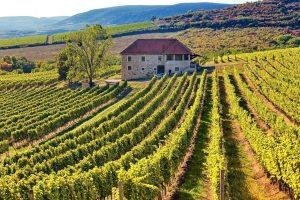
На сайте используются cookie файлы
The site uses cookie files
Данный сайт имеет возрастное ограничение!
This site has age restrictions!
Я подтверждаю, что мне, увы, уже давно исполнилось 18 лет
Dr. Caroline Gilby is a Master of Wine, freelance writer and a consultant, specializing on Central and Eastern Europe. At the International Economic Forum 2021, where Drinks+ was a media partner, she was talking about the usage of native grape varieties in building a marketing narrative.
Why does lack of varieties matter? The varieties matter a lot in Central and Eastern Europe because they offer point of difference in the world looking for the next big thing. The old world be done, the new world is the interpretation of the old world. CEE is s vast huge area with the authentic long history with wine. And grapes that have evolved been selected for the place where they are.
It means if you get people connect select grape that is yours, it connects purchases to your country or your wine region as well. And then it can be used for building a part of a regional story based on an authentic history and a point of difference in the world.

Honestly, stories matter because winemaking nowadays is genially pretty good, the quality of wine is great and that applies in CEE as well. So, what makes you stand out from the mass is the stories. And people like people, they remember the stories about the people behind the wines. Wine is a part of the place as well, of a culture, a history and the people who shape the wines.
The downside of this is of course less well-known, hard-to-pronounce, hard-to-spell grape varieties, maybe with too many accents or not enough vowels. It can be quite challenging, particularly if you try to promote a grape variety from a country nobody ever heard of.
Apart from that, in countries that have strong domestic market such as Romania, Bulgaria, Hungary, the young generation of people coming into wine actually sees the international grape varieties as a glamourous thing. They are not the things that their parents used to drink. So, building a marketing story of local grape varieties to them too is quite important. This is because the volume basing the domestic market earns wineries a lot of money.

In contrast, there are other markets where it is quite impossible, for instance, North Macedonia, Moldova, where the domestic market is so small, that it is all about export. There is a dichotomy, a balance required between what the domestic market wants and what the export market wants.
The other problem is local grapes – not all of them have quality potential. And even when they do have quality potential, most of these grapes have only been being five, ten, maximum 30 years in a new era. So, there is still a question of work in progress for some of them.
If you want to flagship grape, what must it deliver? It must deliver quality; it must be able to reflect a sense of place for that connection to the region and the country and be planted in reasonably substantial quantities. There is no point in trying to develop a flagship grape if it is planted on 10 or 30 hectares. In addition, it hasn’t got to be too difficult to grow and vinify because that does bring challenges, as well as not too hard to spell and pronounce whatever language.
It also helps to have a track record to show it is not just a flash in the pan. The connection to history, to a renowned wine, a reputation over decades, if not centuries, is quite helpful in building a story.
![]()
Caroline Gilby was asked to talk about Romanian grape varieties that might have a potential to become a flagship based on the data of full recent plantings of key local grape varieties. She highlighted the potential of Feteasca Neagra leading over the way – over 3,000 hectares, grown all over the country and there are a few examples of even great wines appearing here and now (however, lots of progress in terms of quality is still required). And it does willing blends, it can age. Feteasca Neagra has the potential to be a flagship for Romania.
“Other local grape varieties can be really interesting, deliver a point of difference, make attractive wines, but I don’t think any of them, at the moment, can be flagships. They can be flagships through a winery and a region, a part of the mosaic of what the country is all about,” noted Ms. Gilby.

It is important if you are going to promote an indigenous grape variety to use an authentic name, even though it might be difficult to pronounce or spell. Translating, for example, Feteasca Neagra to Black Maiden makes it sound detached and doubly. “I would not personally translate,” remarked Ms. Gilby.
Key learnings from Ms. Gilby’s hands-on experience are the following:
Photo: hungarianwines.eu, mastersofwine.org, villamelnik.com, revino.ro